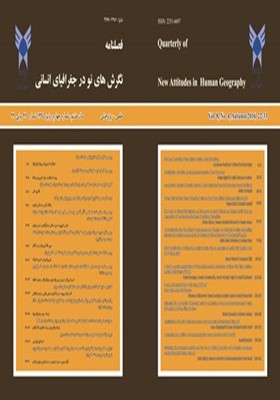بررسی راهکارهای توسعه گردشگری در منطقه آزاد اروند
محورهای موضوعی : کالبدیپریسا سجادی 1 , مجید کریم پور ریحان 2
1 - کارشناس ارشد مدیریت جهانگردی، گرایش برنامهریزی توسعهی جهانگردی، موسسه آموزش عالی قشم، قشم، ایران
2 - دانشیار جغرافیا و آمایش محیط، مرکز تحقیقات بین المللی بیابان، دانشگاه تهران، تهران، ایران
کلید واژه: واژگان کلیدی: توسعهی گردشگری, منطقه آزاد اروند, نرمافزار SPSS, نمودار ستونی, آزمونTتک نمونهای,
چکیده مقاله :
چکیده ﻣﻨﺎﻃﻖ آزاد جایگاه ویژهای در جذب گردشگران داخلی و خارجی دارند، بر همین اساس باید توسعه قابلیتها، امکانات و تسهیلات مورد نیاز جهت افزایش جذب گردشگران مورد توجه قرار گیرد. هدف این پژوهش بررسی راهکارهای توسعه ی گردشگری منطقه آزاد اروند می باشد. پژوهش حاضر توصیفی میباشد. جامعه آماری کلیه کارشناسان و شاغلین و بخش گردشگری در سازمان منطقه آزاد اروند، اداره ی میراث فرهنگی صنایع دستی و گردشگری و شهرداری آبادان، که تعداد آنها 36 نفر است، میباشد. به علت محدودیت جامعه آماری، تمامی افراد مورد آزمون قرار میگیرند. ابزار گردآوری دادهها پرسشنامه محقق ساخته می باشد. در تجزیه و تحلیل دادهها ازآزمونTتک نمونهای با استفاده از نرم افزارSPSSاستفاده میگردد. نتایج تحقیق نشان میدهد که جذب سرمایههای غیر دولتی، زیرساختها و امکانات رفاهی و قابلیت های گردشگری همگی دارای نقشی بسیار موثر در توسعه گردشگری این منطقه می باشند. منطقه آزاد اروند با پتانسیلهای منحصر به فرد خود توانایی رسیدن به جایگاه ویژه ای در زمینه گردشگری و جذب گردشگر را دارد. در پایان راﻫﻜﺎرﻫﺎﻳﻲ درﺟﻬﺖ توسعه توریسم ملی و بین المللی ارائه میگردد.
References
Akhbari, M. and Nami, M.H. (2009). Geography of Border with emphasizing on Iran, Tehran: Geographical Institution of Military Forces [In Persian].
Amanat, H. (2009). “Social Security and its Measurement Pattern”, Journal of Social Security Studies, No. 27, PP. 145-175 [In Persian].
Andalib, A. (2001). Fundamental Theory and Foundations of the Spatial Management of the Borders of I.R.I., Tehran: Publishing of War University [In Persian].
Behforuz, F. (2000). Fundamental Themes in Human Geography, Tehran: University of Tehran [In Persian].
Boggs, S., (2009). International Boundaries: a Study of Boundary Function and Problems. New York, Columbia University Press, second edition.
Cunningham, H. (2002). “Transnational Social Movements and Sovereignties in Transition: Charting New Interfaces of Power at the US-Mexico Border”, Anthropologica, XLIV, pp. 185-196.
GharehBeygi, M., Mottaghi, A. and Rabiei, H. (2014). “Applying of the Spatial Management in Border Organization, Case Study: Border Cities of the Khorasan Jonoubi”, Quarterly bulletin of Greater Khorasan, Vol. 5, No.17, PP. 69-81, [In Persian].
Ghasemi, M.A. (2013). “Religious Democracy and Social Security: Critical Points of the Liberalism and Socialism”, Journal of Strategic Study, No. 64, PP. 65-82, [In Persian].
Hansen, N. (2005). Human Settlement Systems: International Perspectives on Structure, Change and Public Policy, HarperCollins Distribution Services, second edition.
Hawg, P. )2004(. “The historical Process of making non-securitization of security phenomena”, security and globalization, No. 79 and 80, pp. 187-199.
Houtum, H. (2005). “The Geopolitics of Borders and Boundaries”, Geopolitics, No. 10, pp. 672-679.
Jones, P.N., and Wild, T. (1994). “Opening the frontier: recent spatial impacts in the former inner-German border zone, Recent Spatial Impacts in the Former Inner German Border Zone”, Regional Studies, Vol. 28, pp. 259–74.
Karimipour, Y. (2000). New Vision to the Strategic Classification of Borders with emphasizing on Iran, Journal of the faculty of Literature and Human Scinces of University of Tehran, No. 3, PP. 555-568, [In Persian].
Mottaghi, A. (2014). “ Strctural Changes of the Population of I.R.I: Pathology and Measurement of Security Issues”, Journal of Geography, No. 3, Vol. 47, PP. 557-575, [In Persian].
Mottaghi, A. and GharehBeygi, M. (2013). “Studying of the Heterogeneity in Spatial Organization of the Iran’s West Border by using of MCDM”, National Conference of Border, Sustainable Security and Investment chances, Moghan Azad University, [In Persian].
Mottaghi, M., Rabiee, H. and GharehBeygi, M. (2015). Spatial Analysis of the Development in East Borders of Iran, Journal of Economy of Space and Rural Development, No. 4, Vol. 4, PP. 147-167, [In Persian].
Navidnia, M. (2014). “Sociology of Security”, Predicate Journal of the Iranian Association of Sociology, Vol. 57, PP. 2-6, [In Persian].
Newman, D. (2015). “The lines that continue to separate us: Borders in our borderless world”, Progress in Human Geography, Vol. 30 (2), pp. 1–19.
Newman, D. and Paasi, A. (2011). “Fences and neighbors in the post-modern world: boundary narratives in political geography”, Progress in Human Geography, 22 (2), PP. 186–207
Perkmann, M. (2014). “Building governance institutions across European borders”, Regional Studies, Vol. 33, pp. 657–667
Ranjbar, M. (2005). “The Concept of Security in Middle Age Thoughts”, Journal of Strategic Studies, No. 1, Vol. 9, PP. 78-93, [In Persian].
Rashnow, N. (2013). “Comparative Study of the Concept of Security in Recent Security Schools”, Journal of Strategic Studies, No. 66, PP. 7-30, [In Persian].
Robinson, E.H. (2012). “Re-examining Fiat, Bona Fide and Force Dynamic Boundaries for Geopolitical Entities and their Placement in DOLCE”, Applied Ontology, Vol. 7, pp. 93–108.
Rutz, A. (2014). “Grenzen im Raum – Grenzen in der Geschichte. Probleme und Perspektiven. In: Eva Geulen,


